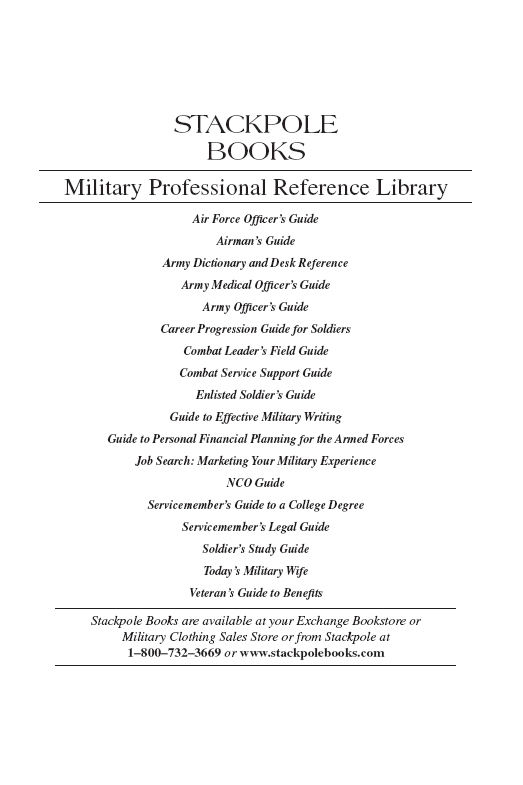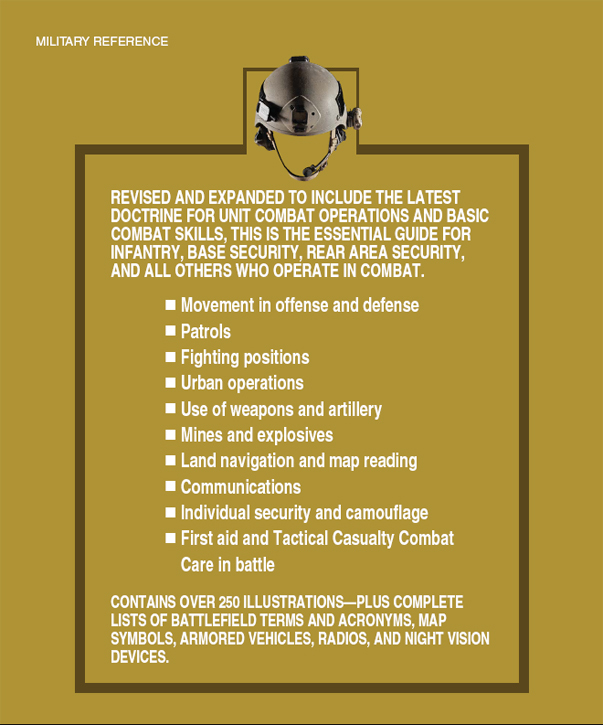antenna, 338–43
environment for, 324
frequencies of, 336–37
manpack, 330–32
operator tasks, 337–38
prowords, 325–26
range of, 335–36
receiver-transmitter, 326–38
rules for use, 324–25
single-channel ground and airborne radio (SINCGAR), 326–32
vehicle-mounted, 332–35
raid, 181
rally point, 167–69
range card, 119–21, 120–21
receiver-transmitter (radio), 326–38
reconnaissance, 139–40
command and control planning and, 18
in defensive operations, 105
for deliberate attack, 80
for offensive operations, 77
in patrolling, 169–74
zone, 171–73
rehearsal
battle drill, 91
checklist for, 41
engagement area, 115
mission success and, 20, 35
reverse planning and, 16
rehearsal area coordination checklist, 41
relief in place, 142–44
resistance, 307
resupply operations, 212–14
reverse slope defense, 136–37
ridgeline, 259
rifle squad leader, 390
rifleman, role of, 390
right to counsel, 344, 346
roadblocks, 158–62
rocket launcher, capabilities of, 393
routes, graphics for, 378
rules of combat, 7
rules of engagement (ROE), 22, 25, 344–55
search and attack movement, 86–87
sector sketch, 122, 123
security
individual movement and, 302–13
radio, 326
self-defense, 348
sensitive site exploration (SSE), 299–300
single-channel ground and airborne radio (SINCGAR), 326–32
examples of, 327–29, 331–32, 334
operator tasks, 337–38
slope, determination of, 256–58
snakebite, first aid for, 296
spinal cord, stabilization of, 290
spoiling attack, 90
squad
formations for, 55–56
movement, 62–63
organization, 388–91
stealth movement, 304–5
Stryker mobile gun system, 217
sun and stars, navigation with, 246–49
survival, techniques for, 306–7
system of measure, 411
tactical combat casualty care (TCCC), 282–84, 286–87, 289
tactical enabling operations, 139–62
air assault operations, 147–54
area security operations, 154–55
checkpoints, roadblocks, and observation points, 158–62
convoy and route security, 155–58
linkup operations, 140–41
passage of lines, 141–42
reconnaissance, 139–40
relief in place, 142–44
withdrawal, 144–46
tanks, 218
capabilities of, 396
fighting position for, 280
infantry riding on, 219–21
recognition of, 355–65
team leader, role of, 390
terrain features, 259–62
threat recognition, 351–52
tourniquet, 290
tracking, 181–82
trail signs, 182
traveling movement technique, 62
traveling overwatch movement technique, 62
trench, enter and clear, 98–101
troop-leading procedures, 14–21
US Army
basic tenets of, 5–6
doctrine, 2
unit, graphics for, 367–72
urban operations, 186–208
building assault, 188–95
clearing techniques, 196–202
combat multipliers in, 207–8
consolidation and reorganization, 202
defensive operations, 203–7
offensive operations, 188–202
urban movement, 186–87
V formation, 59
vehicle checklist, 45
vehicles
fighting position for, 280
graphics for, 375
war, principles of, 4–5
warning order, 15–17
Warsaw Pact armored vehicles, 355–65
weapons and equipment
capabilities of, 393
graphics for, 373–74
organic, 392–95
supporting, 396–98
weapons squad, positioning, 71–72
wedge formation, 54, 60
wire obstacle, 67–69, 113
withdrawal, 26, 144–46
zone reconnaissance, 171–73
About the Author
Jeff Kirkham is a master sergeant in the US Army Special Forces. He owns and operates Praetorian Innovations LLC, providing paramilitary training, evaluation, operational planning, and mission oversight in hostile combat environments. Since 2003, he has spent more than 50 months in Iraq and Afghanistan training, advising, and supporting indigenous elite commando units. He is also president of TwistRate, a web-based company dedicated to helping veteran entrepreneurs or “veteranpreneurs” get their inventions prototyped, funded, and sold. He is the author of the Small Unit Leaders Operational Planning Guide (Blackheart International, 2012).

